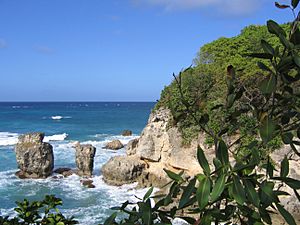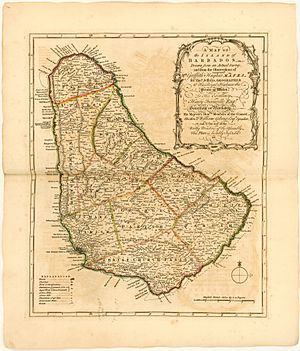Griffith Hughes facts for kids
Quick facts for kids
Griffith Hughes
|
|
|---|---|
| Born | 1707 Tywyn, Merioneth
|
| Nationality | Welsh |
| Education | St John's College, Oxford |
| Occupation | Cleric and author |
| Known for | The Natural History of Barbados |
| Title | Reverend |
| Parent(s) | Edward and Bridget Hughes |
Griffith Hughes (born 1707, died around 1758) was a Welsh clergyman, scientist, and writer. He was also a member of the Royal Society, a famous group for scientists. Hughes is best known for his book, The Natural History of Barbados. This book was the first to describe the grapefruit, which he called "The Forbidden Fruit." A famous scientist named Carl Linnaeus liked his work. However, some people later thought parts of his work might not have been completely accurate.
Contents
Biography of Griffith Hughes
Hughes was born in 1707 in Tywyn, Wales. His parents were Edward and Bridget Hughes. He was christened on April 29.
He went to St John's College, Oxford in England in May 1729. In 1732, he became a priest in London. He then moved to America to lead Welsh church groups. From 1733 to 1736, he worked in Radnor and Evansburg, Pennsylvania. He traveled a lot each week to share his message, mostly in the Welsh language.
In 1736, Hughes left Pennsylvania and moved to St. Lucy's Parish in Barbados. He became the rector (head priest) there. From Barbados, he returned to London to share his discoveries. He published an article in a science journal called Philosophical Transactions of the Royal Society in 1743/4. He also attended a meeting of the Society for the Propagation of the Gospel.
Five years later, he was back in London. He was chosen to be a Fellow of the Royal Society in 1748. Later that same year, he earned his BA and MA degrees from Oxford University. He was listed as the rector of St. Lucy's, Barbados, until 1750. However, it's not clear how much time he spent there after 1743. Records show he lived in London in 1748. His time as rector in Barbados ended when his book was published. The Royal Society noted his presence in London for ten years after 1748. There are no records of him getting married. His land claims in Pennsylvania were given up while he was in Barbados. No one knows what happened to Hughes after 1758.
His Time in Pennsylvania
The Society for the Propagation of the Gospel in Foreign Parts (SPG) helped Hughes join the Anglican mission in colonial Pennsylvania. He worked with two Welsh church groups: St. David's in Radnor and St. James Perkiomen in Evansburg. The SPG appointed him in October 1732 and paid him £60 a year. He arrived in Pennsylvania that winter.
By March 1734, Hughes reported to the SPG that he had traveled over 1,100 miles (1,770 km). He visited many church groups in the Pennsylvania countryside. This included one in the new Lancaster County. In September 1735, he reported that he broke his knee while traveling.
Hughes believed it was important to give Welsh language books to his church members. In December 1734, he offered to go back to London to help translate and publish more books. But the SPG said no. Hughes did publish a Welsh book in Pennsylvania called Myfyrdodau Bucheddol ar y Pedwar Peth Diweddaf. It was about "The Last Four Things." He paid for 150 copies himself, but none of them can be found today. He added some of his own ideas to material from John Morgan, the brother of his hometown vicar.
Letters and wills from that time show that many people wanted Hughes's services. However, he could not meet all the requests. Hughes was the first Welsh rector in that area of Pennsylvania for several years. One dying church member thought highly of Hughes. He left him a horse in his will in 1734. Hughes also started to buy land. He planned to get 400 acres (1.6 km²) in Berks County and 405 acres (1.6 km²) in Lancaster County.
In June 1736, Hughes reported that his health was getting worse. This was made worse by long journeys to Caernarvon, Newtown, and Evansburg. So, he traveled to Barbados and stayed there for three months. He accepted a job at St. Lucy's Parish there. He then returned to Pennsylvania for four months. His departure was sudden. An audit was done by St. David's after he left. Some people complained about his "desertion of his mission." His church group at St. James wrote a letter to the SPG. They said that "the said Mr. Hughes very seldom came near us." Hughes was the last clergyman at St. David's to preach regularly in Welsh.
In 1743, Hughes showed asbestos to the Royal Society. He had brought this material from Pennsylvania. This was long before asbestos was used in industries.
Research on Barbados
While in Barbados, Hughes wrote down what he saw about the island's nature, plants, and animals. He did this over several years. These notes were later put into his book. Hughes arrived in Barbados around the time Codrington College was finished. This also happened when the Royal Society was becoming more important there. Hughes wrote many letters to get help and support for his work and book. Being the rector of St. Lucy's kept him somewhat private on the island. But it also gave him access to important resources.
From Barbados, he likely returned to England in 1743 and 1748. He was at meetings of the SPG in 1743 and the Royal Society in 1748. His first return was when his paper "Of a Zoophyton resembling the Flower of a Marigold" was published. This was the first scientific paper from Barbados. When he returned in 1748, he earned his BA and MA degrees from Oxford. On June 9 of that year, he was elected a Fellow of the Royal Society.
His Book: The Natural History of Barbados
Hughes is remembered for his book The Natural History of Barbados, published in London in 1750. This book was 314 pages long and had ten sections. It also included 29 pictures by artists like Georg Dionysius Ehret.
The book shared many interesting observations:
- The name Barbados comes from a Portuguese word meaning "bearded." This probably describes the fig tree's roots that grow down into the soil.
- Hughes described many uses for the island's plants, including for medicine.
- He gave the first description of the grapefruit, calling it "The Forbidden Fruit."
- He also used the term yellow fever in this book. The link between yellow fever and mosquitoes was discovered much later.
The map for his book was made by Thomas Jefferys. He was a map-maker for King George III. The pictures in the book were drawn by Georg Dionysius Ehret, who was famous for his plant drawings. Hughes was also the first to describe many places on the island from an archaeological point of view. Parts of Hughes's 1750 book were later used in a book about diseases in the West Indies. Other writers like Grainger and Moseley used Hughes's work, especially for information on symptoms and treatments of diseases he saw in Barbados.
What happened to Mr. Hughes after the late 1750s is not fully known. One source says he died in 1778, but doesn't say where. Another source says he returned to Barbados around 1758. This idea matches the records from the Royal Society.
Some critics say that Hughes's book didn't make any big scientific breakthroughs. They also say other books from that time were better. However, many people supported the book, and it was very popular. It was also the first scientific research published that was done right there in Barbados. Carl Linnaeus praised Hughes's work. Even though some later called it a "scientific fraud," the book is still often mentioned in later studies.
See also



